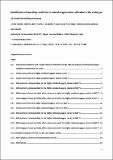Por favor, use este identificador para citar o enlazar a este item:
http://hdl.handle.net/10261/252443COMPARTIR / EXPORTAR:
 SHARE SHARE
 CORE
BASE CORE
BASE
|
|
| Visualizar otros formatos: MARC | Dublin Core | RDF | ORE | MODS | METS | DIDL | DATACITE | |

| Título: | Qualification of operating conditions to extend oxygen carrier utilization in the scaling up of chemical looping processes |
Autor: | Cabello Flores, Arturo CSIC ORCID; Abad Secades, Alberto CSIC ORCID ; Izquierdo Pantoja, María Teresa CSIC ORCID ; Gayán Sanz, Pilar CSIC ORCID ; Diego Poza, Luis F. de CSIC ORCID ; García Labiano, Francisco CSIC ORCID ; Adánez Elorza, Juan CSIC ORCID | Palabras clave: | CO2 capture Chemical looping Operating conditions Oxygen carrier Durability Thermo-chemical stress |
Fecha de publicación: | 24-sep-2021 | Editor: | Elsevier BV | Citación: | Chemical Engineering Journal 430(1): 132602 (2022) | Resumen: | Chemical looping combustion (CLC) is a technology allowing CO2 capture at low cost. The development of durable oxygen carrier materials is a key factor for the scale-up of CLC. Once a promising oxygen carrier has been identified dedicated studies into the effects of reaction conditions on the durability of these kinds of materials are required in order to improve their reliability before use at industrial scale. This method requires several long-term tests in CLC units each one of them to fixed conditions, which is time consuming and expensive. In this work, a low-effort method using thermogravimetric analysis was developed and validated against a high-effort method requiring the use of an oxygen carrier material for hundreds of hours in a CLC unit. The reaction pathways and variation in physico-chemical properties of a material with 14 wt% CuO impregnated on γ-Al2O3 during the course of 300 redox cycles were evaluated as a function of reaction temperature, variation in oxygen carrier conversion (ΔXs) and degree of oxidation/reduction in every redox cycle. As a result, preferred conditions to be used in a CLC unit were identified. In general, reactivity and mechanical integrity were not affected when the reaction temperature was 800 °C. However, a temperature of 900 °C was found to be potentially suitable when the material was highly reduced in each redox cycle and ΔXs was low. The use of this method for promising oxygen carriers can boost the identification of long lasting materials for the scale-up of chemical looping processes. | Descripción: | 16 figures, 5 tables.-- Supplementary information available. | Versión del editor: | http://dx.doi.org/10.1016/j.cej.2021.132602 | URI: | http://hdl.handle.net/10261/252443 | DOI: | 10.1016/j.cej.2021.132602 | ISSN: | 1385-8947 |
| Aparece en las colecciones: | (ICB) Artículos |
Ficheros en este ítem:
| Fichero | Descripción | Tamaño | Formato | |
|---|---|---|---|---|
| 10.1016j.cej.2021.132602.pdf | Artículo principal | 4,22 MB | Adobe PDF |  Visualizar/Abrir |
| 10.1016j.cej.2021.132602_sup info.pdf | Información suplementaria | 795,5 kB | Adobe PDF |  Visualizar/Abrir |
CORE Recommender
SCOPUSTM
Citations
13
checked on 11-may-2024
WEB OF SCIENCETM
Citations
12
checked on 16-feb-2024
Page view(s)
65
checked on 15-may-2024
Download(s)
98
checked on 15-may-2024
Google ScholarTM
Check
Altmetric
Altmetric
Este item está licenciado bajo una Licencia Creative Commons



